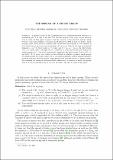Files in this item
The spread of a finite group
Item metadata
| dc.contributor.author | Burness, Timothy C | |
| dc.contributor.author | Harper, Scott | |
| dc.contributor.author | Guralnick, Robert M | |
| dc.date.accessioned | 2022-11-14T15:30:05Z | |
| dc.date.available | 2022-11-14T15:30:05Z | |
| dc.date.issued | 2021-03-01 | |
| dc.identifier | 281947976 | |
| dc.identifier | 3f2da50c-88f1-43e5-8cd3-5fc33f9817bb | |
| dc.identifier | 85103010634 | |
| dc.identifier.citation | Burness , T C , Harper , S & Guralnick , R M 2021 , ' The spread of a finite group ' , Annals of Mathematics , vol. 193 , no. 2 , pp. 619-687 . https://doi.org/10.4007/annals.2021.193.2.5 | en |
| dc.identifier.issn | 0003-486X | |
| dc.identifier.other | ORCID: /0000-0002-0056-2914/work/122216177 | |
| dc.identifier.uri | https://hdl.handle.net/10023/26396 | |
| dc.description.abstract | A group G is said to be 3/2-generated if every nontrivial element belongs to a generating pair. It is easy to see that if G has this property, then every proper quotient of G is cyclic. In this paper we prove that the converse is true for finite groups, which settles a conjecture of Breuer, Guralnick and Kantor from 2008. In fact, we prove a much stronger result, which solves a problem posed by Brenner and Wiegold in 1975. Namely, if G is a finite group and every proper quotient of G is cyclic, then for any pair of nontrivial elements x1,x2∈G, there exists y∈G such that G=⟨x1,y⟩=⟨x2,y⟩. In other words, s(G)⩾2, where s(G) is the spread of G. Moreover, if u(G) denotes the more restrictive uniform spread of G, then we can completely characterise the finite groups G with u(G)=0 and u(G)=1. To prove these results, we first establish a reduction to almost simple groups. For simple groups, the result was proved by Guralnick and Kantor in 2000 using probabilistic methods, and since then the almost simple groups have been the subject of several papers. By combining our reduction theorem and this earlier work, it remains to handle the groups with socle an exceptional group of Lie type, and this is the case we treat in this paper. | |
| dc.format.extent | 49 | |
| dc.format.extent | 863475 | |
| dc.language.iso | eng | |
| dc.relation.ispartof | Annals of Mathematics | en |
| dc.subject | Finite groups | en |
| dc.subject | Generation | en |
| dc.subject | Probabilistic methods | en |
| dc.subject | Simple groups | en |
| dc.subject | Spread | en |
| dc.subject | QA Mathematics | en |
| dc.subject | T-NDAS | en |
| dc.subject.lcc | QA | en |
| dc.title | The spread of a finite group | en |
| dc.type | Journal article | en |
| dc.contributor.institution | University of St Andrews. Pure Mathematics | en |
| dc.identifier.doi | https://doi.org/10.4007/annals.2021.193.2.5 | |
| dc.description.status | Peer reviewed | en |
| dc.date.embargoedUntil | 2021-03-01 | |
| dc.identifier.url | https://research-information.bris.ac.uk/en/publications/the-spread-of-a-finite-group | en |
This item appears in the following Collection(s)
Items in the St Andrews Research Repository are protected by copyright, with all rights reserved, unless otherwise indicated.

